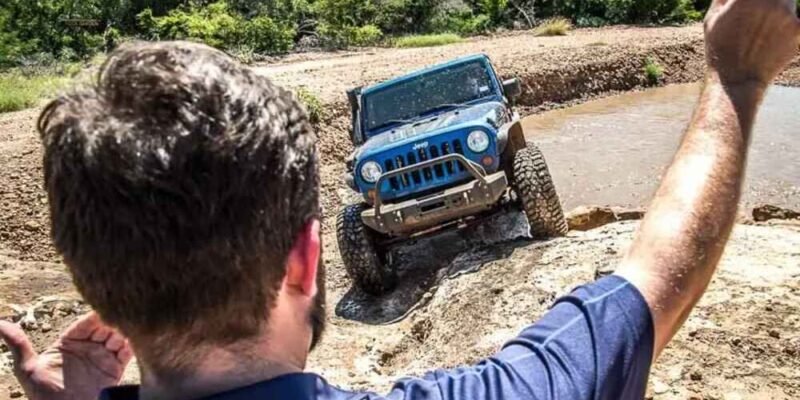Off-road adventures in a 4×4 vehicle offer an unmatched thrill, allowing you to escape the paved roads and explore untamed wilderness. Whether you’re navigating through muddy trails, rocky landscapes, or sandy dunes, the excitement of pushing your vehicle to its limits is exhilarating. However, the challenges of off-road driving require more than just enthusiasm; they demand preparation, skill, and an understanding of your 4×4’s capabilities. Without the right knowledge, even a simple outing can quickly become a daunting task, risking both your safety and your vehicle’s condition.
Whether you’re new to the world of off-roading or a seasoned enthusiast looking to brush up on essential techniques, this guide will help you master the art of 4×4 driving. From understanding how to properly equip your vehicle to learn how to navigate different terrains, these tips will ensure you are fully prepared for your next off-road adventure. With the right approach, you’ll not only tackle any obstacle the trail throws your way but also enjoy a safer and more fulfilling journey into the great outdoors.
Understanding Your 4×4 Vehicle’s Capabilities
Before you hit the trails, it’s essential to understand the capabilities and limitations of your 4×4 vehicle. Not all 4x4s are created equal, and knowing how your vehicle’s systems work can make all the difference when tackling tough terrain. Familiarize yourself with key features such as the different 4WD modes, traction control, and the low-range gearbox. These systems are designed to improve your vehicle’s off-road performance, but only if used correctly.
For instance, using low-range gears is critical for maintaining control on steep hills or when crawling over rocks. This feature allows your vehicle to generate more torque at lower speeds, giving you better traction and control on difficult surfaces. Additionally, understanding when to engage 4WD high or low is crucial. 4WD high is great for sand, mud, or snow, while 4WD low offers more power and control on steep, rocky, or uneven terrain.
Spend time studying your owner’s manual and, if possible, practice using these features in a controlled environment before heading out. This not only helps you get comfortable with your vehicle’s off-road capabilities but also ensures you can confidently adjust your driving techniques based on the conditions you encounter. By truly understanding your 4×4’s systems, you’ll be better equipped to face whatever the trail throws at you.
Proper Tire Selection and Pressure Management
Tires are one of the most critical components of your 4×4 when driving off-road, as they are the only part of your vehicle in direct contact with the terrain. Choosing the right tires and managing tire pressure can drastically improve your off-road performance and ensure your safety. Different terrains require different tire types—mud-terrain tires are ideal for deep mud and loose surfaces, while all-terrain tires strike a balance between on-road comfort and off-road grip.
Equally important is tire pressure management. Adjusting your tire pressure based on the terrain can enhance traction and prevent unnecessary damage to both the tires and the terrain. For soft surfaces like sand or mud, lowering the tire pressure creates a larger surface area, allowing the tires to “float” on the surface rather than sink into it. This can prevent your vehicle from getting bogged down. On rocky or hard surfaces, slightly higher tire pressure is better to prevent sidewall damage and ensure proper grip.
It’s important to invest in a quality tire pressure gauge and a portable air compressor so you can make adjustments on the go. Keep in mind that while airing down your tires improves traction off-road, you’ll need to inflate them back to the recommended pressure for safe highway driving once you’re back on paved roads. Proper tire selection and pressure management are simple yet powerful strategies to maximize your 4×4’s capability and ensure a smoother, safer ride in any off-road adventure.
Mastering Terrain Navigation Techniques
Off-road driving is about more than just brute force—it’s about finesse and understanding how to navigate different types of terrain. Each type of surface, from sand to mud to rocky trails, requires specific techniques to ensure you maintain control, protect your vehicle, and avoid getting stuck. Developing these skills can transform your off-road experience from a bumpy, stressful ride into a smooth and enjoyable adventure.
For sand or loose gravel, momentum is your best friend. Keep a steady pace to avoid getting bogged down. Avoid sudden stops or rapid acceleration, as this can cause your wheels to dig into the surface and make it harder to regain traction. Use the high-range 4WD setting to maintain speed while distributing power evenly to all four wheels.
When navigating rocky terrain, slow and steady is the key. In these conditions, your vehicle’s low-range gear system should be engaged, allowing you to carefully crawl over obstacles without losing traction. Always take the time to assess the path ahead, considering your approach and departure angles to avoid damaging your undercarriage. Pay attention to wheel placement, aiming for high ground or smoother sections whenever possible.
For muddy surfaces, the objective is to maintain forward momentum without spinning your wheels. Use low-range 4WD to keep traction and avoid excessive acceleration that could cause you to lose control. Sometimes, momentum alone won’t be enough, so consider reducing tire pressure to gain extra traction, but be cautious not to go too low on sharp or rocky areas to avoid punctures.
Mastering these navigation techniques will help you handle whatever terrain comes your way, making your off-road adventure more successful and enjoyable.
Essential Recovery Gear and Tools
Even the most experienced off-road drivers can encounter unexpected challenges, which is why having the right recovery gear is essential for any 4×4 adventure. Being prepared with the proper tools not only ensures you can get out of tough situations but also minimizes the risk of damaging your vehicle in the process.
The first piece of equipment every off-roader should have is a high-quality recovery strap or tow rope. These are essential for pulling a stuck vehicle out of mud, sand, or snow. Make sure the strap is rated for your vehicle’s weight, and always use appropriate recovery points on the vehicle to avoid causing damage or injury. Additionally, carrying a set of D-shackles or soft shackles will help you safely attach the recovery strap to your vehicle or another vehicle assisting in the recovery process.
A winch is another valuable tool, especially for solo adventures. Mounted on the front of your vehicle, a winch allows you to pull yourself out of difficult situations by anchoring to a tree or another sturdy object. However, using a winch requires practice and proper safety procedures to prevent accidents, so it’s important to familiarize yourself with its operation before you need it.
Other essential recovery items include a sturdy shovel for digging out stuck tires, traction boards to provide grip on slippery surfaces, and a tire repair kit in case you experience a puncture far from civilization. A portable air compressor is also important for adjusting tire pressure after recovery or after navigating particularly challenging terrain.
Having the right recovery gear and knowing how to use it is a critical part of off-road safety. With the proper tools, you’ll be better prepared to handle unexpected challenges and get back on the trail swiftly and safely.
Reading and Respecting the Terrain
One of the most important skills for any off-road driver is the ability to read the terrain. Off-road environments can be unpredictable, with hidden obstacles and changing conditions that can quickly turn a fun adventure into a risky situation. Taking the time to assess and understand the terrain before driving is essential for both safety and the preservation of the natural environment.
Before approaching any new terrain, stop and evaluate the area. Look for potential hazards like large rocks, deep ruts, tree stumps, or steep slopes. Water crossings can be particularly tricky—never assume they are shallow or passable. If you’re uncertain, it’s always a good idea to walk the crossing first to check the depth and firmness of the ground underneath. Similarly, when dealing with steep inclines or descents, assess the angle and the condition of the trail before proceeding. Sometimes, it’s safer to find an alternative route than risk damage to your vehicle or getting stuck.
Respecting the environment is equally important. Driving off marked trails can damage ecosystems, cause erosion, and disturb wildlife. Stick to established tracks to minimize your environmental impact. Avoid sensitive areas like wetlands, and be cautious not to spin your tires excessively, as this can dig deep ruts and scar the landscape. Always aim to leave no trace—this not only helps preserve nature but ensures that the trails remain accessible for future off-road enthusiasts.
Understanding and respecting the terrain is key to a successful off-road adventure. By carefully reading the landscape and making informed decisions, you’ll protect both your vehicle and the environment while enjoying a safer, more enjoyable journey.
Safety First: Group Travel and Communication
When it comes to off-roading, safety should always be your top priority, and one of the best ways to enhance safety is by traveling in a group. Off-road environments are often remote, and unexpected situations can arise quickly, such as a mechanical breakdown or getting stuck in difficult terrain. Having others around can make these situations easier to handle, offering extra hands for vehicle recovery or assistance in case of an emergency. Plus, it’s simply more enjoyable to share the adventure with friends or fellow off-road enthusiasts.
In addition to traveling with others, maintaining clear communication is crucial. In remote areas, cell service is often unreliable, so having two-way radios or walkie-talkies allows you to stay in contact with your group. These devices are especially useful when vehicles become separated by dense terrain or obstacles. Some off-roaders also invest in satellite phones or GPS devices that work in areas without cell reception, ensuring they can call for help if needed.
It’s also a good practice to let someone outside your group know your travel plans, including your route and expected return time. In case of an emergency, this person can alert authorities if you haven’t checked in by the designated time.
Another important aspect of safety is having a first aid kit and basic survival gear on hand. Off-roading can take you into unpredictable environments, where minor injuries or vehicle malfunctions may occur far from help. Carrying enough water, food, and emergency supplies will help you manage unexpected delays.
By traveling in a group, using proper communication tools, and being prepared with emergency supplies, you’ll significantly reduce the risks of off-road adventures and ensure a safer, more enjoyable experience for everyone involved.
Conclusion
Off-road driving offers an exciting escape from the everyday, allowing you to explore the great outdoors in a way few experiences can match. However, it’s essential to be well-prepared and knowledgeable to ensure both safety and success on the trails. By understanding your 4×4 vehicle’s capabilities, managing your tires properly, mastering terrain navigation, equipping yourself with essential recovery tools, reading and respecting the terrain, and prioritizing safety through group travel and communication, you’ll be ready for any off-road adventure.
With the right mindset and preparation, off-roading can be a rewarding and thrilling way to enjoy nature while challenging your driving skills. Keep these tips in mind, and you’ll not only conquer tough terrain but also have a safe, fun, and memorable experience on every off-road journey.
Also, read interesting articles at Disboard.co.uk













